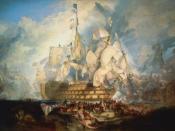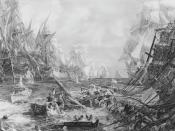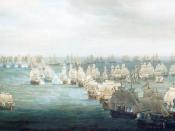The Battle of Trafalgar was one of the most celebrated naval engagements in European history. The battle was fought on Oct. 21, 1805 off Cape Trafalgar on the southern coast of Spain. Collingwood and Horatio Nelson were the British commanders against a slightly larger fleet combined of France and Spain. The two combined armies were commanded by Pierre Charles de Villeneuve of France and d'Aliva and Cisternas of Spain. Already France was the biggest military power in Europe because of the power Napoleon Bonaparte gained from the other Napoleonic wars won. This battle was different for Napoleon because the power he gained was only on land and since the Battle of Trafalgar was a naval battle Britain had an advantage.
The battle started soon after France's enemy began blocking the French ports and disrupting France's overseas trade. In the fall of 1805, French warships escaped the blockade and joined with Spanish warships to form a fleet of 33 ships.
The French and Spanish fleet fought a British fleet of 27 warships off the southwest coast of Spain, at the mouth of the Mediterranean Sea. The British commander, Admiral Horatio Nelson, was known as a brilliant naval strategist who gave Britain even more of an advantage. When the battle began, he sent his ships right into the center of the French and Spanish formation. The daring tactic surprised the two combined fleets. The British sank or disabled 25 enemy ships without losing one of their own when Nelson sent his ships in.
A French sniper soon wounded Nelson during the battle. Needing to clear the British from the English Channel to allow an invasion, Napoleon Bonaparte attempted to have his navy escape the British blockade, draw the battle from Europe to the West Indies and then return to hold the...


